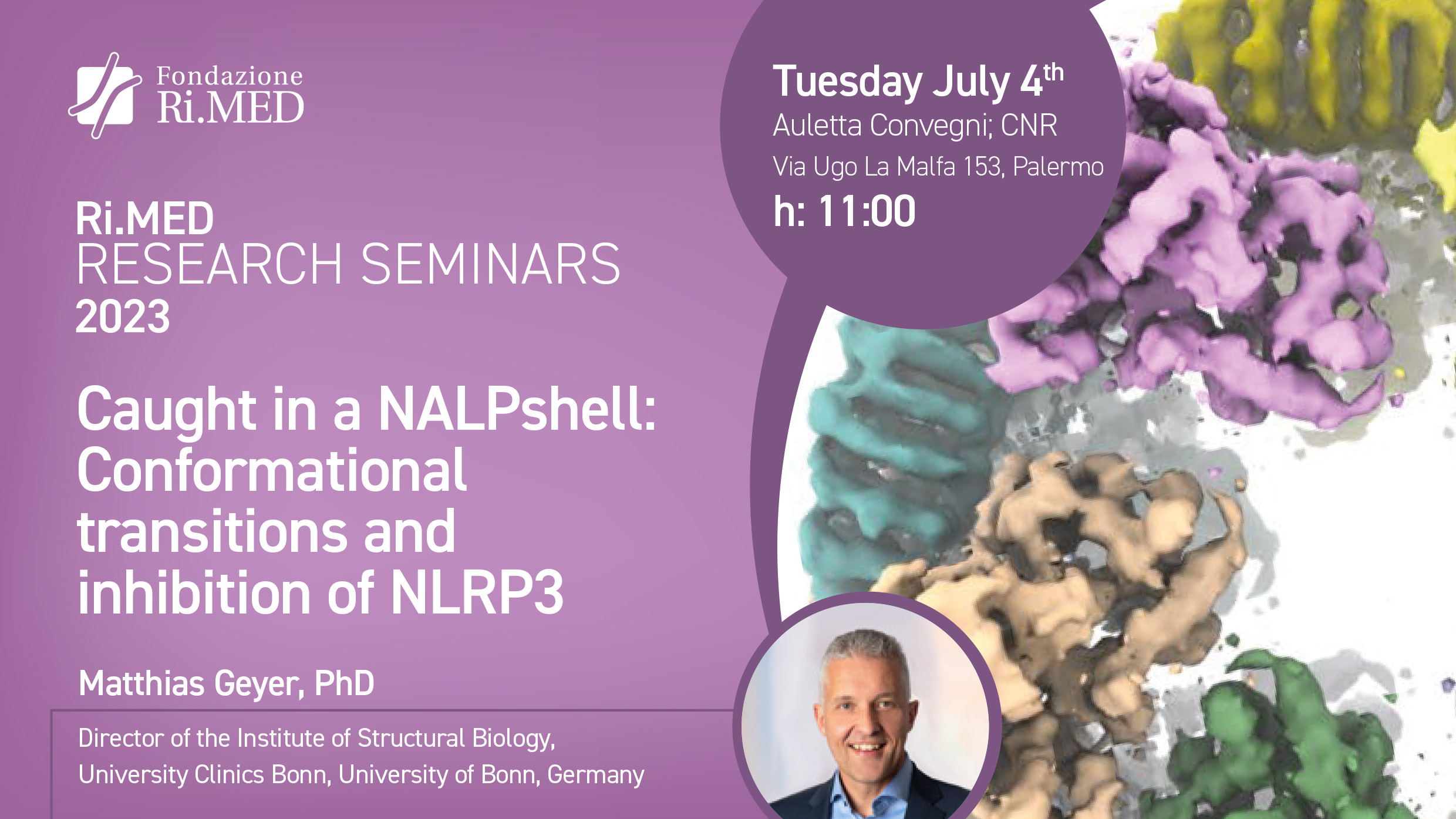The fifth Ri.MED Research Seminar took place on Tuesday 4th July, h 11:00, at Auletta Convegni, CNR, Via Ugo La Malfa,153 Palermo:
“Caught in a NALPshell: Conformational transitions and inhibition of NLRP3”
by Prof. Matthias Geyer, Director of the Institute of Structural Biology, University Clinics Bonn, University of Bonn, Germany
Abstract: NLRP3 is an intracellular sensor protein that when activated by a broad spectrum of exogenous and endogenous stimuli leads to inflammasome formation and pyroptosis. Its dysregulation has been linked to chronic inflammation and diseases relevant to today’s ageing society. Yet, we only begin to understand the conformational transitions of NLRP3 and the way antagonistic small molecules act. We have determined the cryo-EM structures of full-length human NLRP3 in its inactive form and bound to the inhibitor MCC950. Native NLRP3 is a decamer composed of homodimers of intertwined LRR domains that assemble back-to-back as pentamers. The effector Pyrin domain is shielded inside the decamer cage providing a safeguard mechanism against accidental activation. Binding of MCC950 considerably stabilizes the NACHT and LRR and inhibits ATPase activity. MCC950 binds with nanomolar affinity into a cleft, connecting four subdomains of the NACHT with the transition LRR. Its central sulfonylurea group interacts with the Walker A motif of the NLRP3 nucleotide-binding domain and is sandwiched between two arginines. Binding experiments demonstrate that MCC950 can be extended without loss of interaction, and that substitution of the furan moiety could be an option for the development of advanced NLRP3 inhibitors with lower hepatotoxicity. Moreover, we determined a crystal structure of NLRP3–MCC950 at 2.4 Å resolution and the tripartite NLRP3–MCC950–NEK7 complex revealing the mode of inhibition. With the determination of the binding site of this key therapeutic agent, specific targeting of NLRP3 for the treatment of autoinflammatory and autoimmune diseases and rational drug optimization is within reach.
Biosketch: Matthias Geyer studied Physics in Kiel, Bonn, and Heidelberg and graduated in Biophysics at the Max Planck Institute for Medical Research in Heidelberg. Working in the department of Kenneth C. Holmes he was trained in structural biology with an emphasis on nucleotide-binding proteins. In 1999 he moved as a research assistant to the HHMI laboratory of Matija Peterlin at UCSF. Coming back to Germany, he spent 10 years as an independent research group leader within the Max Planck Society, working at the Max Planck Institute of Molecular Physiology, Dortmund, and the Research Center caesar, Bonn. He obtained the habilitation in biochemistry from the Medical Faculty at Heidelberg University. In 2014, he joined the Institute of Innate Immunity headed by Eicke Latz at the University of Bonn, setting up a research department in biochemistry and structural biology. Since 2015, he is a core member of the excellence cluster ImmunoSensation and appointed to the Cluster Chair of Structural Immunology. In 2017, Matthias Geyer became the founding director and chair of the Institute of Structural Biology at the Medical Faculty of the University of Bonn.
Dr. Geyer is using a broad range of biochemical methods to determine protein–protein interactions as well as the interaction to lipids, nucleic acids, and small molecular ligands. His laboratory is applying X-ray crystallography, NMR spectroscopy, and electron microscopy for the structural analysis of protein complexes. His group investigates the activation and formation of the inflammasome, the regulation of eukaryotic transcription, and the remodelling of the actin cytoskeleton.

